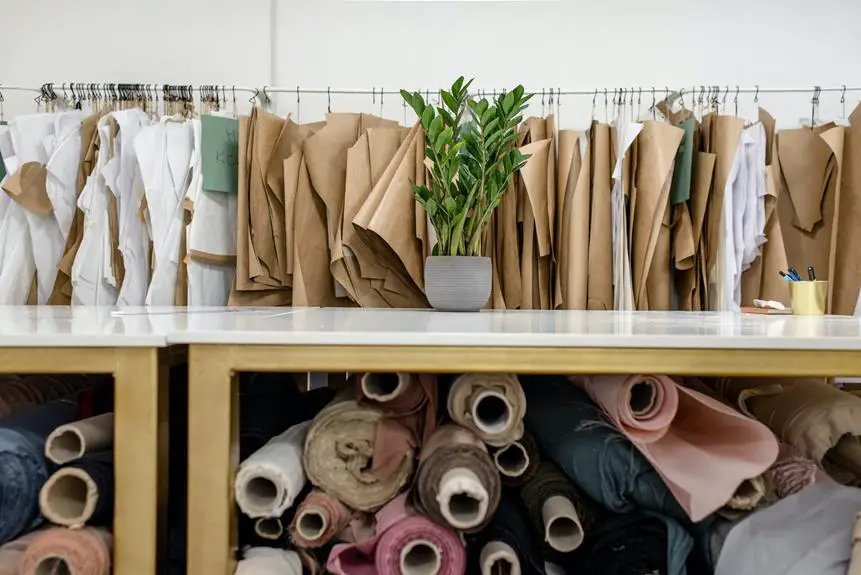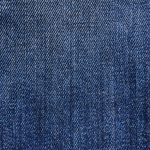Struggling to sew knit fabric without it stretching or puckering? Mastering the art of stabilizing knit fabric can make all the difference in achieving professional-looking results.
By following these 5 tips, you'll be able to confidently work with knit fabrics, ensuring a smooth and polished finish to your projects.
Key Takeaways
- Consider the weight and stretch of the knit fabric when choosing a stabilizer.
- Use stay tape for shoulder seams to prevent stretching and provide structural support.
- Clear elastic is a versatile option for stabilizing necklines and hems on knit fabric.
- Use twin needles and appropriate needles to achieve professional finishes.
Choosing the Right Stabilizer
Choose the right stabilizer by considering the weight and stretch of your knit fabric. There are various types of interfacing available, each suited to different fabrics and purposes.
When working with knit fabric, it's essential to use stabilizer to prevent stretching and distortion during sewing. For light to medium weight knits, a lightweight knit interfacing or tricot interfacing is suitable. These provide support without adding too much bulk.
For heavier knits, such as sweatshirt fleece or ponte knit, consider using a medium to heavyweight stabilizer to maintain the fabric's structure. Additionally, when sewing knits with stretch, opt for a stretch stabilizer to ensure that the fabric retains its elasticity.
Stabilizers are also beneficial when working with knit fabrics that have a tendency to curl at the edges. By selecting the appropriate stabilizer, you can enhance the overall quality of your knit fabric projects and achieve professional-looking results.
Using Stay Tape for Shoulder Seams
When working with knit fabric, you can stabilize shoulder seams by using stay tape to prevent stretching and ensure structural support. Stay tape offers several benefits, including maintaining the shape of the garment, providing reinforcement to the shoulder seams, and preventing them from stretching out of shape over time.
To apply stay tape effectively, follow these tips:
- Cut the stay tape to the length of the shoulder seam and attach it to the wrong side of the fabric.
- Secure the stay tape in place using pins or clips to ensure it stays straight during the sewing process.
- Stitch the shoulder seam carefully, ensuring that the stay tape is securely attached and the fabric isn't stretched or distorted.
- Press the seam allowance towards the back of the garment, using a pressing cloth to protect the fabric and the stay tape.
Employing Clear Elastic for Necklines and Hems
For stabilizing necklines and hems on knit fabric, there are a few options you can consider. One popular choice is to use clear elastic. Clear elastic is a versatile option as it provides support without adding bulk to the fabric. To apply clear elastic to a neckline, you will need to measure the length needed and slightly stretch it as you sew it to the wrong side of the fabric. You can use a zigzag stitch to secure the elastic in place while keeping the fabric flat. This method works well for lightweight knits and helps maintain the shape of the garment over time.
Another option to consider is using stretch fusible tapes or strips. These alternatives offer a similar stabilizing effect and are applied using an iron. They can be a good choice for those who prefer not to use clear elastic or for different types of fabric that may require a different approach.
It's always a good idea to experiment with different stabilizing techniques to see which one works best for your specific project and fabric. By trying out different methods and materials, you can achieve professional and polished results in your knit fabric sewing projects.
Exploring Twin Needles for Professional Finishes
To achieve professional finishes when working with knit fabric, consider employing twin needles to create neat and durable hemlines and decorative stitching. Additionally, experimenting with various stabilizing techniques will help you achieve polished results in your knit fabric sewing projects.
- Needle Types: Use ballpoint or stretch needles when sewing with knit fabrics to prevent snags and runs in the fabric.
- Stitch Spacing: Adjust the stitch spacing on your sewing machine to accommodate the width of the twin needle. This will ensure that the needle doesn't hit the presser foot or needle plate, resulting in broken needles or damage to the machine.
- Thread Tension: Check and adjust the thread tension to prevent the threads from breaking or looping when using a twin needle.
- Practice and Testing: Before working on your final project, practice using the twin needle on scrap knit fabric to ensure the desired stitch quality and appearance.
Mastering Stabilizing Stitches and Techniques
Master the art of stabilizing knit fabric by utilizing effective stitches and techniques.
When dealing with fabric stretchiness, using seam tape can be an effective method for stabilizing knit fabrics. Seam tape is a thin strip of woven or knit material that's applied to the seam allowances to prevent stretching and distortion. It helps to stabilize the seams and prevents them from stretching out of shape during wear and washing.
When sewing with knits, applying seam tape to shoulder seams, armholes, and neckline edges can help maintain the shape and structure of the garment. Additionally, using a stretch stitch or a narrow zigzag stitch on your sewing machine can help to stabilize the fabric while still allowing for some stretch. These stitches are ideal for maintaining the stretch and preventing popped seams in knit fabrics.
Frequently Asked Questions
Can Knit Fabric Be Stabilized Using Non-Traditional Materials Such as Interfacing or Fusible Web?
Yes, knit fabric can be stabilized using non-traditional materials like interfacing or fusible web. These options help prevent stretch and are suitable for serger sewing. Fusible web and interfacing provide effective stabilization for knit fabrics.
How Can I Prevent My Knit Fabric From Stretching Out While Sewing and Wearing?
To prevent stretching in knit fabric when sewing and wearing, handle it carefully. Use proper sewing techniques like using a walking foot or a stretch stitch. Always prewash and dry the fabric to minimize future stretching.
Are There Any Specific Tips for Stabilizing Knit Fabric When Sewing on a Serger or Overlocker Machine?
To stabilize knit fabric when using a serger or overlocker machine, consider using a stabilizing tape or clear elastic in the seams. These alternatives can effectively prevent stretching and ensure a professional finish for your knit fabric projects.
Can I Use Stabilizing Techniques for Knit Fabric When Sewing With a Regular Sewing Machine as Well?
Yes, you can use stabilizing techniques for knit fabric when sewing with a regular sewing machine. Consider using non-traditional materials like interfacing or fusible web to stabilize the fabric and prevent stretching.
What Are Some Alternative Methods for Stabilizing Knit Fabric if I Don't Have Access to Traditional Stabilizer Materials?
If you lack traditional stabilizer materials, consider DIY stabilizing techniques for knit fabric. Look into home remedies and alternatives such as using lightweight interfacing, clear elastic, or stay tape to stabilize your fabric when sewing.
- The Use of Nonwovens in Construction and Civil Engineering - July 11, 2025
- The Use of Nonwovens in Construction and Civil Engineering - July 11, 2025
- The Use of Nonwovens in Construction and Civil Engineering - July 11, 2025







